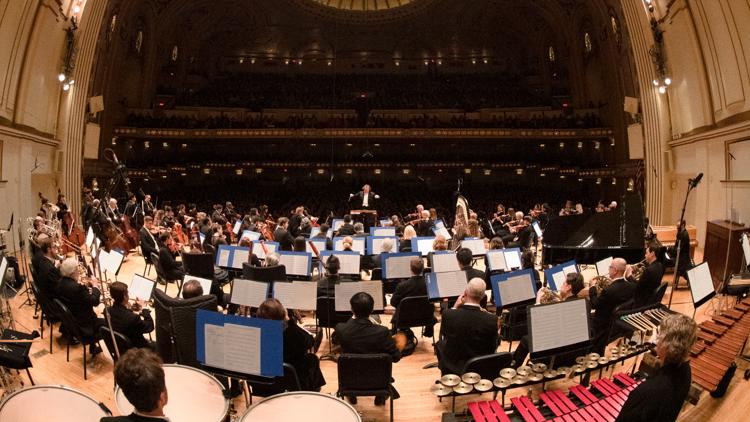ST. LOUIS — Symphony percussionists don't suffer an image problem like rock drummers, the butt of a notorious tradition of dumb jokes, but they do stand apart from the rest of the orchestra. They are not very often heard, playing accents on many pieces, and not very clearly seen in the back of the room, like where the bad kids sit in class. They make their music by banging on things with sticks.
The most recent Live at the Sheldon concert on Wednesday, March 6 curated by St. Louis Symphony Orchestra musicians was called “Percussion Spotlight.” Live at the Sheldon, a new series this season, quickly became a hot ticket, so this concert was still well attended while visibly less packed than its predecessors. I have a hunch that the small drop-off in audience interest could be attributed to the focus on percussion. I suspect some of the symphony faithful thought those noisy instrument beaters would be making a racket in the Sheldon.
SLSO principal Timpani Shannon Wood curated a program that could be understood as a methodical attack on that sort of assumption. Far from a symphonic drum circle, Wood booked himself as a one-man percussion section (not counting the appearances of piano), who chose music for the program that made his colleagues on strings and winds shine. The only percussion solo was a for-real drum solo that had to be heard and seen to be believed (we’ll come back to that).
Wood opened the program with a piece where the percussion – one single side drum – was almost inaudible. He closed the night with a suite where the composer – Igor Stravinsky – taught himself percussion to cut musician costs in performing the piece. In between, we heard a world premiere by a student composer, one of Wood’s own pieces that also deemphasized percussion, and that nearly indescribable drum solo. No dumb drummer jokes here: that was brilliant programming, particularly for an audience that might be fearing a mighty racket, and Wood spoke about the work with a confident eloquence that rose to the level of the Leonard Slatkins and Stéphane Denèves.
The first half of the program – which featured four pieces! – might have been better titled “Cello Spotlight,” since SLSO cellist Elizabeth Chung was everywhere. Her cello lines walked and soared all over Bohuslav Martinu’s Quartet for clarinet, horn, cello, and side drum (1924). In the world premiere of Osterreich (2023) by Mizzou student composer Morima Yerby (a cellist himself), Chung ran a clinic on all of the sounds a cello can make: distorted like punk rock, sliding like an alarm sounding, aching like we normally expect from a cello, and you can slap it with your bow like a drum.
Martinu’s quartet features brilliant ensemble writing, so Chung shared the spotlight with Victoria Knudson on horn and especially Tzuying Huang on clarinet. The composite colors of various groupings of those three instruments were practically visible in the concert hall. Given the joyous workout that Stravinsky gives the clarinet and Huang in his Suite from ‘Historie du soldat’ (1918), which concluded the program, this show, again, could have been titled “Clarinet Spotlight” as credibly as putting the percussion out front on the marquee.
In the curator-percussionist’s own piece, Abballanu Cifalutani (which premiered in 2015), the spotlight falls on the English horn, performed by Cally Banham, who commissioned the piece. Wood said he tried to transpose a tarantella into jazz idioms, adapting chord progressions by Bill Evans and Chick Corea. The result was intense, yet fun and spry, and it got Banham dancing with her horn – snaky body English with English horn – a rare burst of physical expressiveness in a concert where the musicians’ attention always engaged almost entirely with the score and their instruments, rather than one another.
In Stravinsky’s suite, which is about as much fun as you can have while holding orchestral instruments, Wood directed the spotlight away from his drums, again, this time toward Shawn Weil on violin. Booking Weil for this part is what the musician-curated Live at the Sheldon chamber series is all about. By day, Weil is one of the orchestra’s busiest and least visible pit musicians, sawing away in the Second Violins so that others may solo and sparkle. And here he was holding the only violin on stage and playing it like (literally) the devil! Who knew a virtuoso toils in the cheap seats of the Second Violins?
Then there was that crazy drum solo, Brujo for solo percussion (1981) by Richard Schwarz. Wood intrigued us by saying the composer developed the piece after working in Ghana and then went “off the grid,” essentially disappearing. Wood then asked us to wait for him as he went backstage to “tie goat nails and gourd seeds” around his ankles. Wood does not come across as ironic or sarcastic, so I fully expected him to emerge with goat nails and gourd seeds tied around his ankles, and I simply had to trust he would not also dress down to a loin cloth and go all folkloric. Indeed, he remained in his business casual attire, tying these new percussive elements around the legs of his slacks.
What he did behind that suite of drums with those goat nails and gourd seeds tied around his pant legs had to be heard and seen to be believed. At times, all four of his limbs kept different tempos. The one-man percussion section became a one-man polyrhythm. Then, there was those odd timbres lent by the goat and the gourds. It got loud. What a racket! What a racket those percussionists were making in the Sheldon, even if there were only one of them.


